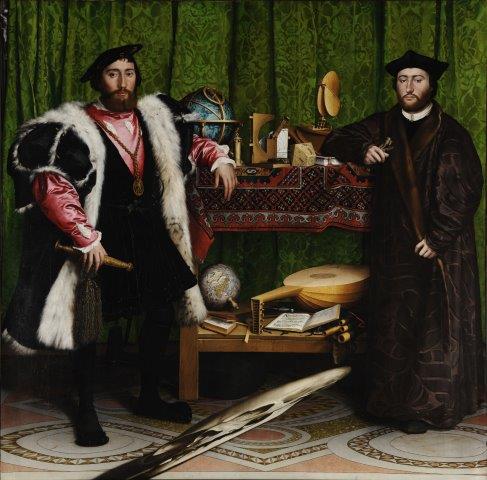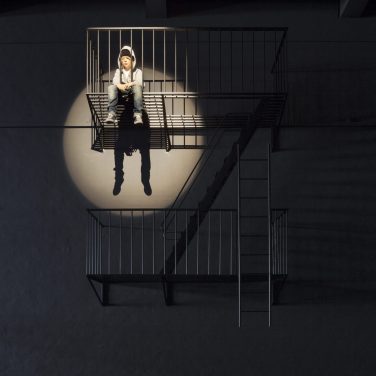Vanity Fair
Yael Maly
 By Hans Holbein - Wikipedia
By Hans Holbein - Wikipedia
The masterpiece “The Ambassadors” can teach us something about Ecclesiastes – and the reverse
In the book of Ecclesiastes, the attitude towards human successes can be summed up in one word: vanity. And in two: vanity of vanities. The word “vanity” is mentioned 36 times in the book. Apparently the author of the text fears that this is a difficult message to absorb. The term “vanity”, also known as “Vanitas”, has been represented many times in European art. Dealing with pride and the finite nature of life is difficult for everyone; not only for us, the Jews. The painting “The Ambassadors” is an exceptional representation of Vanitas, and indirectly illuminates what is written in the Book of Ecclesiastes, to which we will refer at the end of the article.
Hans Holbein the Younger (1497–1543) was a German painter working in the Northern Renaissance style, which was characterized, among other things, by sharp realism, precision of details, and symbolism. Holbein, who moved to England and specialized in painting portraits in the court of King Henry VIII, became the most important artist in England at that time.
In the famous painting before us, known as the “Ambassadors” (1533), two distinguished figures stand against the background of a green curtain. The identity of the figures has become clear over the years: the figure on the left is that of the patron who ordered the painting, 29-year-old Jean de Dinteville (his age is engraved on the dagger in his hand), who served as France’s ambassador to England. The figure on the right is that of 25-year-old Georges de Selve, Bishop of Lavaur in France (his age is marked on the edge of the book on which his elbow rests). De Selve also served during his short life as French Ambassador to the Republic of Venice.
The two stand on a luxuriously embellished marble floor. These floor tiles still exist today in Westminster Abbey, the royal abbey where the kings and queens of England are crowned and married, and where they have also been buried alongside the great figures of the British nation for more than 500 years now.
The two friends stand on either side of a bookcase covered with an oriental rug, as was the custom in the Low Countries in those days. At that time, rugs were considered as luxury items that should be put on display, rather than stepped on. Thanks to the realistic depiction, it can be seen that this is a good quality rug imported from Anatolia, in the Ottoman Empire. The spectacular patterns woven into it attest not only to a love of aesthetic luxuries, but also to the system of political and economic ties forged between King Francis I of France and King Henry VIII of England, and the Ottoman Sultan Suleiman the Magnificent.
The cabinet that separates, but also connects, the two ambassadors is divided horizontally into two planes. On the top shelf stand a globe of the celestial bodies, and astronomical measuring instruments. On the lower shelf on the right is a lute with one broken string, and peeking out in the corner are bagpipes, also lacking one pipe. In the front, a book of psalms composed by Martin Luther, the father of the Christian Reformation, is wide open.
The book of notes and the lute are painted with astonishing foreshortening. On the left – a globe on which the map of the world is drawn lies on its side. This underscores the importance of the continent of Europe, painted in gold. In front of the globe is a semi-closed booklet, with records of commercial profit and loss calculations.
What does a broken string symbolize?
The piece commemorates two young and successful friends, who are very different from each other. Dinteville, dressed in magnificent and ornate clothes and holding a dagger, is portrayed as a practical man, self-confident and extroverted. De Selve wears a more modest fur coat, and places his forearm on a book, emphasizing that he is an introverted intellectual. The objects placed next to them testify to their occupations, their wisdom and breadth of education in the fields of science and music, and also their solid economic status. In the obvious sense, the painting is a status symbol. However, the work is strewn with signs that hint at the difficulties the two faced. They were Catholics living in England, which had at that time parted from the Catholic Church and chosen the Anglican religion. The year the painting was created was one of the most tumultuous in the life of Henry VIII, known as a serial killer of his wives. As a diplomat, Dinteville had to navigate a dark and tangled political world. Placing the lute next to Luther’s psalter raises the hypothesis that the broken string expresses the inter-religious tension created between Catholics and Protestants following the rise of the Protestant religion.
The globe leaning on its side next to the account book, which highlights the act of division, indicates the difficulties experienced by the ambassador, the man of action who may not be able to “conquer the world”, as appears to be seen from the navigation tools scattered on the top shelf. The lute missing a string and the bagpipes, which also, as mentioned, lack a pipe, reveal that even in the life of the spiritual man, the melody may jar.
The painting not only hints at cracks in the world of the two successful men and the fragility of life, but also includes the presence of death itself. Over the colorful marble floor tiles hovers an unidentified object, which looks like a strange surfboard. It emerges diagonally in motion into the lower part of the painting, and disturbs the viewer’s peace of mind. It is a distorted skull, and this is what gave the work its great renown. The skull is realistically depicted in many European paintings, and symbolizes Vanitas, or the Latin phrase “Memento Mori” – “Remember the day of death”. Here the skull is painted using the technique of anamorphosis (an artistic device creating an illusion through a distortion of perspective, and requiring the viewer to use certain instruments or a different point of view to identify an element hidden in the work). It can be seen only when the viewer stands at an angle to the image, and tilts his head to look at it. The skull looks like a reflection in a distorting mirror, like an incomprehensible stain on the floor. Moreover, from the point of view from which it can be understood, all the other objects and figures will look wrong. It turns out that the artist, who so realistically and accurately depicted the figures and the many objects, chose to present the skull in a distorted way that undermines the harmony of the entire work.
This is not the only riddle in the painting. In the upper left corner, a small figurine of Christ peeks out from between the folds of the curtain, seeming to be an observer who sees and is not seen. The learned pair seem unaware of the tiny figure of Christ, just as they do not notice the large skull lying at their feet.
A meeting with death
In this case, what is the subject of the work? The wealth, the honor, or the professional and spiritual success of two young people who have achieved greatness? At first glance, we admire the artistic abilities of Holbein the Younger, as well as the impressive figures. A second look arouses our empathy towards the ambassadors. We notice the difficulties that are faced even by people who have had dizzying success at such a young age.
A third look is both surprising and shocking. Holbein the Younger makes us divert our gaze and look at the picture in a completely different way. The painting enables us, the viewers, to open an aperture and meet the infinite within the finite. But to do that we have to make an effort, to change our direct and comfortable angle of vision. The sublime (in the Christian sense symbolized by the figurine) can be met if we raise our glance, turn our heads, and look beyond the curtain.
Is it really possible to meet the metaphysical world? The divine providence? Holbein leaves the question open. True, the viewer may notice the image hidden between the folds of the curtain, but if we draw conclusions from the behavior of the ambassadors, then in the “real” world, human beings “turn their backs” on God, who observes them and watches over their actions.
The “death” signified by the anamorphic skull can be seen only when we move away from the picture to the end of the hall, and look from the side and on a curve; and when the spectacular painting, with all its precise details, appears blurry to us, then the skull – and only the skull – will be revealed before our eyes. In other words, we will meet the death “lying at our feet” when our feet trip over it: until then it will be lying in our path as an unidentified object.
It turns out that the painting is about what is not seen, what is hidden from the eye. The devices that are illustrated represent the best human achievements that the 16th century had made in studying the world, but at the same time it reminds us that there are limits to earthly life, human vision, and human knowledge.
Olam (World) from the term “ne’elam” (disappeared)
The Book of Ecclesiastes describes at length man’s material and intellectual achievements: “I gathered me also silver and gold, and treasure such as kings and the provinces have as their own; I got me men-singers and women-singers, and the delights of the sons of men, women very many” (Ecclesiastes 2:8). And as is said again and again, “[…] vanity of vanities, all is vanity. What profit hath man of all his labor wherein he laboreth under the sun?” (ibid, 1:2-3). Does the author of the text reject the vanities of this world?
Let us look at one of the hard to comprehend verses by comparison with “The Ambassadors”, and with its help propose a few keys to understanding the contradictory messages arising from the text. Kohelet says: “He hath made every thing beautiful in its time; also He hath set the world in their heart, yet so that man cannot find out the work that God hath done from the beginning even to the end” (3:11).
The phrase “also He hath set the world in their heart” in the primary sense of the “world” as the “universe”. Holbein presents the earthly world and the heavenly world through the two globes. The perfect circles on the floor also symbolize the universe. Rashi, in his commentary on this verse, writes:
“Even the wisdom of the world which he gave in the heart of mankind did not give everything in the heart of each and every one, but a little to one and a little to another, so that man will not find all the deeds of the Holy One, blessed be He, to know Him, and will not know the time of his death and where he will fail, to give heart to return.”
Rashi clarifies why life is not perfect, why a string is broken and a globe is on its side. His explanation is also reminiscent of the division between the two ambassadors. One is the man of deeds and war, holding a dagger in his hand; the other is the man of spirit and poetry (it is possible that Holbein hints at his preference for the world of the spirit, represented by the open book of Psalms, as opposed to the world of action, represented by the dagger and the closed book of accounts, from which exercises in division, the world of wars and losses peek). If the whole world were in our hands, we would not “give heart to return”.
World is also from the same root as “disappeared”, hidden. Rashi goes on to explain:
“If he were to be anxious and say today or tomorrow I will die, and therefore it is written here ‘ha’elem’ without the vowel from the root “ha’alma”, since if man knew [that] the day of his death was near, he would not build a house or plant a vineyard. To this he says ‘everything is good in its time’, the fact that there is a time to die – it is a beautiful thing that a person has the trust to say this, that the time of his death is still far off, and he builds a house and plants a vineyard, and it is beautiful that it is concealed from the people.”
In the second part, Rashi explains why ignorance of death makes life possible. This interpretation reminds us of the ambassadors’ lively presence in the shadow of the death that will not be revealed to them, and is also incomprehensible to the viewer. The word ‘olam’ (world) can also be interpreted as forever, ‘ad olam’, and thus echo Holbein’s intention in painting the figurine.
In the Book of Ecclesiastes, diverse voices and conflicting ideas are gathered together. Sukkot is called the Feast of Ingathering. Precisely on this holiday, when the people of Israel would sit (in a good year) under its vine and under its fig tree, satisfied with itself, its power and the strength of its hand, precisely at this time the tradition comes to undermine us. Instead of sitting in a solid stone house, we sit in a rickety sukkah. And the peace of mind that prevails on the Feast of Ingathering is accompanied by a reading of the Book of Ecclesiastes, which casts doubt on all our achievements, material and spiritual alike. It spreads out before us possibilities for looking at life and death from different angles, optimistic and pessimistic, simplistic and complex, earthly and spiritual, and leads to the conclusion that only belief in the eternity of God and the limitations of human understanding give meaning to the life of this world. “The end of the matter, all having been heard: fear God, and keep His commandments; for this is the whole man. For God shall bring every work into the judgment concerning every hidden thing, whether it be good or whether it be evil” (12:13-14).
* A chapter from the book “Art as Interpretation” on the festivals of Israel, to be published ahead of the year 5722






